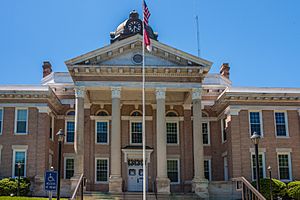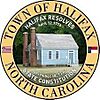Halifax, North Carolina facts for kids
Quick facts for kids
Halifax, North Carolina
|
||
|---|---|---|

Halifax County Courthouse
|
||
|
||

Location of Halifax, North Carolina
|
||
| Country | United States | |
| State | North Carolina | |
| County | Halifax | |
| Area | ||
| • Total | 0.46 sq mi (1.18 km2) | |
| • Land | 0.46 sq mi (1.18 km2) | |
| • Water | 0.00 sq mi (0.00 km2) | |
| Elevation | 121 ft (37 m) | |
| Population
(2020)
|
||
| • Total | 170 | |
| • Density | 371.99/sq mi (143.55/km2) | |
| Time zone | UTC-5 (Eastern (EST)) | |
| • Summer (DST) | UTC-4 (EDT) | |
| ZIP code |
27839
|
|
| Area code(s) | 252 | |
| FIPS code | 37-28920 | |
| GNIS feature ID | 2406637 | |
Halifax is a small town in Halifax County, North Carolina, United States. In 2020, about 170 people lived there. It is the main town, or county seat, of Halifax County.
Halifax is famous as "The Birthplace of Freedom." This is because on April 12, 1776, leaders in Halifax adopted the Halifax Resolves. This was the first time a colony officially called for independence from Great Britain. Today, you can visit the Halifax Historic District, a special place that helps tell this important story.
Contents
Exploring Halifax: Location and Land
Halifax is located in North Carolina, right on the Roanoke River. The town sits near a special place called the Fall Line. This is where the higher lands of the Piedmont region meet the flatter Coastal Plain.
Being near the Fall Line meant that boats could travel up the Roanoke River only so far. This made Halifax an important spot for trade and travel in early times. All of the town's area is land, about 0.4 square miles (1.18 square kilometers).
Who Lives in Halifax: Population Facts
The number of people living in Halifax has changed over many years. Here's a look at how the population has grown and shrunk:
| Historical population | |||
|---|---|---|---|
| Census | Pop. | %± | |
| 1860 | 192 | — | |
| 1870 | 429 | 123.4% | |
| 1880 | 376 | −12.4% | |
| 1890 | 361 | −4.0% | |
| 1900 | 306 | −15.2% | |
| 1910 | 314 | 2.6% | |
| 1920 | 299 | −4.8% | |
| 1930 | 321 | 7.4% | |
| 1940 | 374 | 16.5% | |
| 1950 | 346 | −7.5% | |
| 1960 | 370 | 6.9% | |
| 1970 | 335 | −9.5% | |
| 1980 | 253 | −24.5% | |
| 1990 | 327 | 29.2% | |
| 2000 | 344 | 5.2% | |
| 2010 | 234 | −32.0% | |
| 2020 | 170 | −27.4% | |
| U.S. Decennial Census | |||
Halifax's Population in 2020
In 2020, there were 170 people living in Halifax. These people lived in 82 households, which are like family units or groups of people living together. About 45 of these households were families.
The people living in Halifax come from different backgrounds:
| Group | Number | Percentage |
|---|---|---|
| White (not Hispanic) | 111 | 65.29% |
| Black or African American (not Hispanic) | 51 | 30.0% |
| Other/Mixed | 2 | 1.18% |
| Hispanic or Latino | 6 | 3.53% |
Halifax's Past: A Look at History
Halifax was officially started in 1757. It was named after George Montagu-Dunk, the 2nd Earl of Halifax. He was an important leader in trade for Great Britain at the time. In 1759, Halifax became the main town for the new Halifax County.
The Birthplace of Freedom
During the time of the American Revolution, Halifax became a very important place for business and politics. In the spring of 1776, North Carolina's Fourth Provincial Congress met in Halifax. On April 12, they made a very important decision called the Halifax Resolves. This document was the first official step by a colony to ask for independence from British rule. It showed that North Carolina was ready to be free!
Historic Places to See
Many old and important buildings in Halifax are listed on the National Register of Historic Places. This means they are protected because of their historical value. Some of these places include:
- The Church of the Immaculate Conception and the Michael Ferrall Family Cemetery
- The William R. Davie House
- The Eagle Tavern
- The Halifax County Courthouse
- The Halifax County Home and Tubercular Hospital
- The Halifax Historic District (the whole area)
- The Sally-Billy House
- And St. Mark's Episcopal Church
These places help us remember the rich history of Halifax and its role in forming the United States.
Famous People from Halifax
Many interesting people have come from Halifax, North Carolina. Here are a few:
- William Cicero Allen (1859–1952), who was an educator.
- John Branch (1782–1863), a politician.
- John R. J. Daniel (1802–1868), also a politician.
- Junius Daniel (1828–1864), a military officer.
- Lucille Gorham (1931–2012), a civil rights activist who worked for equal rights.
- Samuel E. Hogg (1783–1842), another politician.
- Bartholomew F. Moore (1801–1878), a politician.
See also
 In Spanish: Halifax (Carolina del Norte) para niños
In Spanish: Halifax (Carolina del Norte) para niños


